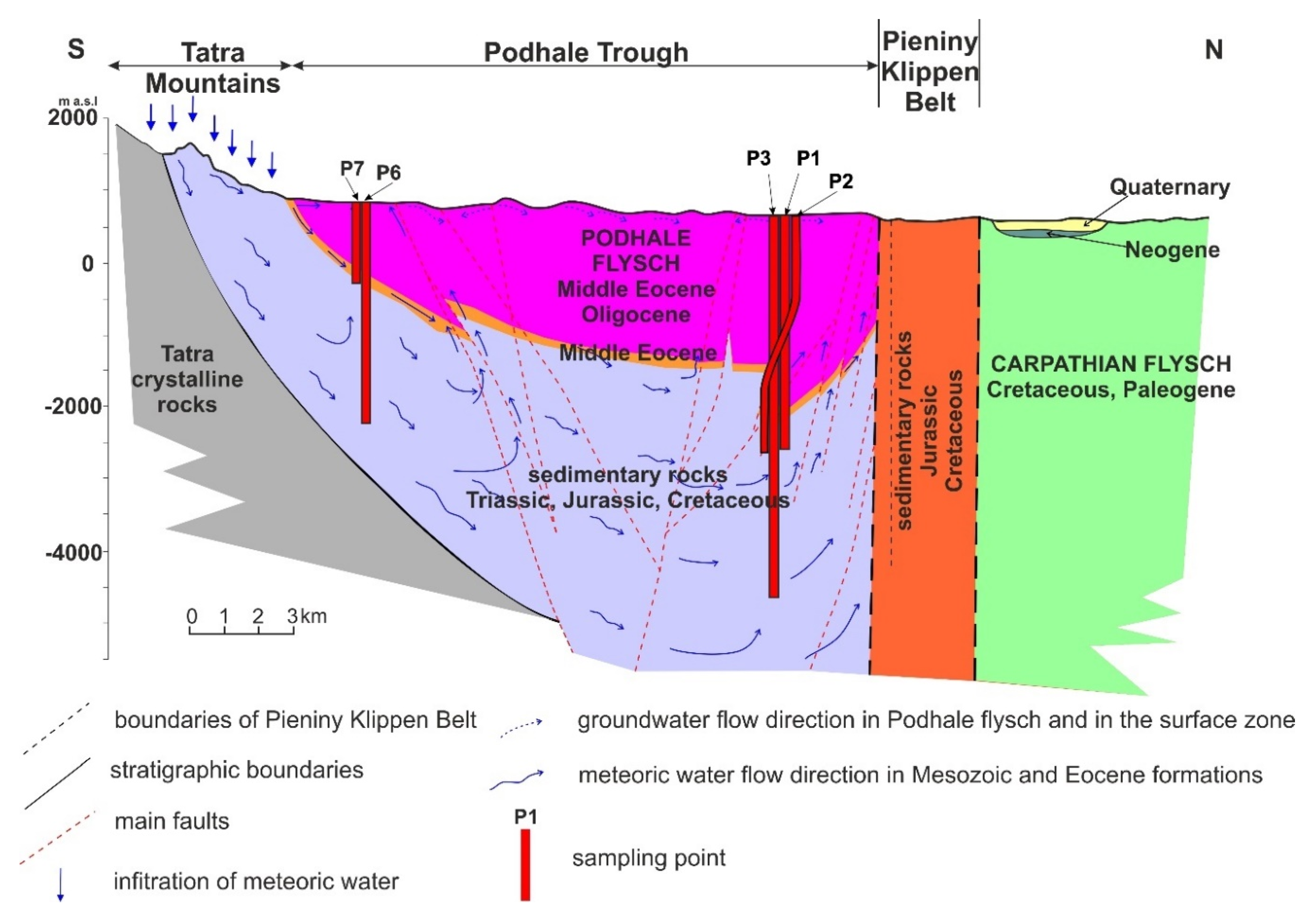Hydrogeochemistry and Related Processes Controlling the Formation of the Chemical Composition of Thermal Water in Podhale Trough, Poland
Abstract
1. Introduction
2. Materials and Methods
3. Results and Discussion
3.1. Hydrogeochemical Characteristic
3.2. Calculation of the Mineral Saturation Indices
3.3. Hydrochemical Indices
3.4. Formation of Water Chemical Composition
4. Conclusions
Supplementary Materials
Author Contributions
Funding
Conflicts of Interest
References
- Yang, P.; Cheng, Q.; Xie, S.; Wang, J.; Chang, L.; Yu, Q.; Zhan, Z.; Chen, F. Hydrogeochemistry and geothermometry of deep thermal water in the carbonate formation in the main urban area of Chongqing; China. J. Hydrol. 2017, 549, 50–61. [Google Scholar] [CrossRef]
- Apollaro, C.; Vespasiano, G.; Muto, F.; De Rosa, R.; Marini, L. Use of mean residence time of water, flowrate, and equilibrium temperature indicated by water geothermometers to rank geothermal resources. Application to the thermal water circuits of Northern Calabria. J. Volcanol. Geotherm. Res. 2016, 328, 147–158. [Google Scholar] [CrossRef]
- Bujakowski, W.; Tomaszewska, B.; Miecznik, M. The Podhale geothermal reservoir simulation for long-term sustainable production. Renew. Energy 2016, 99, 420–430. [Google Scholar] [CrossRef]
- Mehl, V.; Johannsen, K. Calculating chemical speciation; pH; saturation index and calcium carbonate precipitation potential (CCPP) based on alkalinity and acidity using OpenModelica. J. Water Supply Res. Technol.—AQUA 2018, 67, 1–11. [Google Scholar] [CrossRef]
- Olivier, J.; Van Niekerk, H.J.; Van der Walt, I.J. Physical and chemical characteristics of thermal springs in the Waterberg area in Limpopo Province; South Africa. Water SA 2008, 34, 163–174. [Google Scholar] [CrossRef]
- Süer, S.; Güleç, N.; Mutlu, H.; Hilton, D.R.; Çifter, C.; Sayin, M. Geochemical Monitoring of Geothermal Waters (2002–2004) along the North Anatolian Fault Zone; Turkey: Spatial and Temporal Variations and Relationship to Seismic Activity. Pure Appl. Geophys. 2008, 165, 17–43. [Google Scholar] [CrossRef]
- Tomaszewska, B.; Kmiecik, E.; Wątor, K.; Tyszer, M. Use of numerical modelling in the prediction of membrane scaling. Reaction between antiscalants and feedwater. Desalination 2018, 427, 27–34. [Google Scholar] [CrossRef]
- Tomaszewska, B.; Pająk, L. Dynamics of clogging processes in injection wells used to pump highly mineralized thermal waters into the sandstone structures lying under the Polish Lowland. Archiv. Environ. Protect. 2012, 38, 103–117. [Google Scholar] [CrossRef]
- Gheorghe, A.; Grǎciun, P. Thermal aquifers in Romania. J. Hydrol. 1993, 145, 111–123. [Google Scholar] [CrossRef]
- Vaselli, O.; Minissale, A.; Tassi, F.; Magro, G.; Seghedi, I.; Ioane, D.; Szakacs, A. A geochemical traverse across the Eastern Carpathians (Romania): Constraints on the origin and evolution of the mineral water and gas discharges. Chem. Geol. 2002, 182, 637–654. [Google Scholar] [CrossRef]
- Fendek, M.; Rebro, A.; Fendekova, M. A spell cast: Historical aspects of thermal spring use in the Western Carpathian Region. In Stories From a Heated Earth: Our Geothermal Heritage, 1st ed.; Cataldi, R., Hodgson, S.F., Lund, J.W., Eds.; Geothermal Resources Council; International Geothermal Association: Sacramento, CA, USA, 1999; pp. 251–265. [Google Scholar]
- Varga, C. Volatile organics in thermal spa waters: Active ingredients or environmental toxicants. Thermae Spa Med. 2012, 1, 1–8. [Google Scholar]
- Barbacki, A.; Bujakowski, W.; Pająk, L.; Ney, R. Atlas of Geothermal Water Reservoirs in Malopolska; Wydawnictwo Instytutu Gospodarki Surowcami Mineralnymi i Energią PAN: Kraków, Poland, 2006. (In Polish) [Google Scholar]
- Kasztelewicz, A. Selected mineralogical and petrographic aspects of the reservoir rock of the Podhale geothermal system. Tech. Poszuk. Geolog. Geotermia Zrówn. Rozwój 2018, 1, 105–117. (In Polish) [Google Scholar]
- Kępińska, B. Warunki Termiczne I Hydrotermalne Podhalańskiego Systemu Geotermalnego, 1st ed.; Wydawnictwo IGSMiE PAN: Kraków, Poland, 2006. (In Polish) [Google Scholar]
- Chenaker, H.; Houha, B.; Vincent, V. Hydrogeochemistry and geothermometry of thermal water from north-eastern Algeria. Geothermics 2018, 75, 137–145. [Google Scholar] [CrossRef]
- Wątor, K.; Dobrzyński, D.; Sugimori, K.; Kmiecik, E. Redox potential research in the field of balneochemistry: Case study on equilibrium approach to bioactive elements in therapeutic waters. Int. J. Biometeorol. 2020, 64, 815–826. [Google Scholar] [CrossRef] [PubMed]
- Tomaszewska, B. The prognosis of scaling phenomena in geothermal system using the geochemical modeling methods. Miner. Resour. Manag. 2008, 24, 399–407. [Google Scholar]
- Tomaszewska, B.; Dendys, M. Zero-waste initiatives—Waste geothermal water as a source of medicinal raw material and drinking water. Desalin. Water Treat. 2018, 112, 12–18. [Google Scholar] [CrossRef]
- Gerardo, J.Y.; Nuti, S.; D’Amore, F.; Seastres, J., Jr.; Gonfiantini, R. Isotopic evidence for magmatic and meteoric water recharge and the processes affecting reservoir fluids in the Palinpinon geothermal system, Philippines. Geothermics 1993, 22, 521–533. [Google Scholar] [CrossRef]
- Lambrakis, N.J.; Stamatis, G.N. Contribution to the study of thermal waters in Greece: Chemical patterns and origin of thermal water in the thermal springs of Lesvos. Hydrol. Process. Int. J. 2008, 22, 171–180. [Google Scholar] [CrossRef]
- Lambrakis, N.; Kallergis, G. Contribution to the study of Greek thermal springs: Hydrogeological and hydrochemical characteristics and origin of thermal waters. Hydrogeol. Geol. J. 2005, 13, 506–521. [Google Scholar] [CrossRef]
- Marques, J.M.; Carreira, P.M.; Carvalho, M.R.; Matias, M.J.; Goff, F.E.; Basto, M.J.; Rocha, L. Origins of high pH mineral waters from ultramafic rocks; Central Portugal. Appl. Geochem. 2008, 23, 3278–3289. [Google Scholar] [CrossRef]
- He, K.; Stober, I.; Bucher, K. Chemical evolution of thermal waters from limestone aquifers of the Southern Upper Rhine Valley. Appl. Geochem. 1999, 14, 223–235. [Google Scholar] [CrossRef]
- Lipiec, I.; Wątor, K.; Kmiecik, E. The application of selected hydrochemical indicators in the interpretation of hydrogeochemical data—A case study from Busko-Zdroj and Solec-Zdroj (Poland). Ecol. Indic. 2020, 115, 106460. [Google Scholar] [CrossRef]
- Vengosh, A.; Helvacı, C.; Karamanderesi, I.H. Geochemical constraints for the origin of thermal waters from western Turkey. Appl. Geochem. 2002, 17, 163–183. [Google Scholar] [CrossRef]
- Besser, H.; Mokadem, N.; Redhaounia, B.; Hadji, R.; Hamad, A.; Hamed, Y. Groundwater mixing and geochemical assessment of low-enthalpy resources in the geothermal field of southwestern Tunisia. Euro-Mediterranean J. Env. Integ. 2018, 3, 16. [Google Scholar] [CrossRef]
- Foued, B.; Hénia, D.; Lazhar, B.; Nabil, M.; Nabil, C. Hydrogeochemistry and geothermometry of thermal springs from the Guelma region, Algeria. J. Geol. Soc. India 2017, 90, 226–232. [Google Scholar] [CrossRef]
- Mendonca, J.L.; da Silva, M.O.; Bahir, M. Considerations concerning the origin of the Estoril (Portugal) thermal water. Estud. Geológicos 2004, 60, 153–159. [Google Scholar]
- Venturelli, G.; Boschetti, T.; Duchi, V. Na-carbonate waters of extreme composition: Possible origin and evolution. Geochem. J. 2003, 37, 351–366. [Google Scholar] [CrossRef]
- Chowaniec, J.; Poprawa, D.; Witek, K. Occurrence of thermal waters in the Polish Carpathians (southern Poland). Przegląd Geolog. 2001, 49, 734–742. (In Polish) [Google Scholar]
- Korzec, K. Charakterystyka Hydrogeochemiczna Wód Termalnych w Rejonie Bańskiej Niżnej. Ph.D. Thesis, AGH University of Science and Technology, Kraków, Poland, 2016. (In Polish). [Google Scholar]
- Mika, A.; Wątor, K.; Kmiecik, E.; Sekuła, K. Determination of iodine in geothermal water samples—Preliminary ICP-MS method validation results. Water Sci. Tech. W. Sup. 2019, 19, 1264–1270. [Google Scholar] [CrossRef]
- Porowski, A. Chemical and Isotopic Characteristics of Thermal Waters in the Carpathian Region; South Poland: Implication to the Origin and Resources. In Thermal and Mineral Waters, 1st ed.; LaMoreaux, J.W., Ed.; Springer: Tuscaloosa, AL, USA, 2014. [Google Scholar] [CrossRef]
- Rusiniak, P.; Ruszczyńska, A.; Wątor, K.; Bulska, E.; Kmiecik, E. Methodological aspects concerning sampling and determination of total selenium and selenium species in geothermal waters. Bull. Geogr. Phys. Geogr. Ser. 2020, 18, 5–16. [Google Scholar] [CrossRef]
- Shvartsev, S.L.; Sun, Z.; Borzenko, S.V.; Gao, B.; Tokarenko, O.G.; Zippa, E.V. Geochemistry of the thermal waters in Jiangxi Province; China. Appl. Geochem. 2018, 96, 113–130. [Google Scholar] [CrossRef]
- Chowaniec, J.; Duliński, M.; Mochalski, P.; Najman, J.; Śliwka, I.; Zuber, A. Environmental tracers in thermal water of Podhale Basin. Przegląd Geol. 2009, 57, 685–693. (In Polish) [Google Scholar]
- Oszczypko, N.; Zuber, A. Geological and isotopic evidence of diagenetic waters in the Polish Flysch Carpathians. Geol. Carpath. 2002, 53, 257–268. [Google Scholar]
- Porowski, A. Origin of mineralized waters in the central Carpathian synclinorium; SE Poland. Studia Geol. Pol. 2006, 125, 5–67. [Google Scholar]
- Witczak, S. Analiza i Interpretacja Składu Fizyko-Chemicznego Wód Eksploatowanych W Białym Dunajcu I Bańskiej Pod Kątem Poznawania Systemu Geotermalnego Podhala, 1st ed.; Arch. IGSMiE PAN: Kraków, Poland, 1999. (In Polish) [Google Scholar]
- Dz. U. 2011 nr 163 poz. 981 Polish Geological and Mininig Law. Available online: https://isap.sejm.gov.pl/isap.nsf/download.xsp/WDU20111630981/U/D20110981Lj.pdf (accessed on 1 September 2020). (In Polish)
- Hałaj, E. Geothermal bathing and recreation centres in Poland. Environ. Earth Sci. 2015, 74, 7497–7509. [Google Scholar] [CrossRef][Green Version]
- Kępińska, B.; Ciągło, J. Możliwość zagospodarowania wód geotermalnych Podhala do celów balneoterapeutycznych i rekreacyjnych [Possibilities of use of the Podhale geothermal waters for balneotherapeutical and recreational purposes]. Geologia 2008, 34, 541–559. (In Polish) [Google Scholar]
- Kępińska, B. Model Geologiczno-Geotermalny Niecki Podhalańskiej, 1st ed.; Wyd. CPPGSMiE PAN: Kraków, Poland, 1997; pp. 5–11. (In Polish) [Google Scholar]
- Dowgiałło, J. Occurrence and use of mineral and thermal waters in Poland. Environ. Earth Sci. 2012, 67, 2251–2259. [Google Scholar] [CrossRef]
- ISO 5667-11. Water Quality—Sampling—Part 11: Guidance on Sampling of Groundwaters; ISO: Geneva, Switzerland, 2009. [Google Scholar]
- Kmiecik, E.; Wątor, K.; Tomaszewska, B.; Sekuła, K.; Mika, A. Methodological aspects of pH and EC measurements in geothermal water. Bull. Geogr. Phys. Geogr. Ser. 2019, 17, 39–47. [Google Scholar] [CrossRef]
- EN 27888. Water Quality—Determination of Electrical Conductivity, 1993; Comite Europeen de Normalisation: Brussels, Belgique, 1993. [Google Scholar]
- ISO 10523. Water Quality—Determination of pH; ISO: Geneva, Switzerland, 2008. [Google Scholar]
- Standard Methods. Standard Methods for the Examination of Water and Wastewater, 22nd ed.; American Public Health Association: Washington, DC, USA; American Water Works Association: Denver, CO, USA; Water Environment Federation: Alexandria, VA, USA, 2012. [Google Scholar]
- ISO 11885. Water Quality—Determination of Selected Elements by Inductively Coupled Plasma Optical Emission Spectrometry (ICP-OES); ISO: Geneva, Switzerland, 2007. [Google Scholar]
- ISO 17294-2. Water Quality—Application of Inductively Coupled Plasma Mass Spectrometry (ICP-MS)—Part 2: Determination of Selected Elements Including Uranium Isotopes; ISO: Geneva, Switzerland, 2016. [Google Scholar]
- ISO 9297. Water quality—Determination of Chloride—Silver Nitrate Titration with Chromate Indicator (Mohr’s Method); ISO: Geneva, Switzerland, 1989. [Google Scholar]
- ISO 9963-1. Water Quality—Determination of Alkalinity—Part 1: Determination of Total and Composite Alkalinity; ISO: Geneva, Switzerland, 1994. [Google Scholar]
- PN-C-04566-03. Woda I Ścieki—Badania Zawartości Siarki I Jej Związków—Oznaczanie Siarkowodoru I Siarczków Rozpuszczalnych Metodą Tiomerkurymetryczną; Polish Commenttee for Standardization: Warsaw, Poland, 1982. (In Polish) [Google Scholar]
- Miller, J.N.; Miller, J.C. Statistics and Chemometrics for Analytical Chemistry, 5th ed.; Pearson Education: Harrow, UK, 2005. [Google Scholar]
- Otto, M. Chemometrics: Statistics and Computer Application in Analytical Chemistry, 3rd ed.; Wilet-VCH: Freiberd, Germany, 2016. [Google Scholar]
- Wątor, K.; Kmiecik, E.; Lipiec, I. The use of principal component analysis for the assessment of the spatial variability of curative waters from the Busko-Zdrój and Solec-Zdrój region (Poland)–Preliminary results. Water Supply 2019, 19, 1137–1143. [Google Scholar] [CrossRef]
- Kmiecik, E.; Korzec, K. Ocena stabilności składu chemicznego wód termalnych ujmowanych otworem Bańska PGP-1 w Bańskiej Niżnej; Podhale—Analysis of chemical composition stability of thermal water from Bańska PGP-1 well; Podhale. Przegląd Geol. 2015, 63, 830–833. (In Polish) [Google Scholar]
- Wątor, K.; Mika, A.; Sekuła, K.; Kmiecik, E. Assessment the impact of samplers change on the uncertainty related to geothermal water sampling. In Proceedings of the E3S Web of Conferences Water, “Water, Wastewater and Energy in Smart Cities”: The First Conference of the International Water Association IWA for Young Scientist in Poland, Kraków, Poland, 12–13 September 2018; pp. 1–8. [Google Scholar]
- Mika, A.; Korzec, K. Ocena stabilności stężeń kwasu metakrzemowego w wodach termalnych ujmowanych otworem Bańska PGP-1 w Bańskiej Niżnej—Analysis of the concentration stability of metasilic acid in the thermal water from the Bańska PGP-1 well. Tech. Poszu. Geolog. Geoterm. Zrówn. Rozwój 2015, 54, 89–96. (In Polish) [Google Scholar]
- Pazdro, Z.; Kozerski, B. Hydrogeologia Ogólna, 1st ed.; Wydawnictwa Geologiczne: Warsaw, Poland, 1990. (In Polish) [Google Scholar]
- Witczak, S.; Kania, J.; Kmiecik, E. Katalog Wybranych Fizycznych I Chemicznych Wskaźników Wód Podziemnych I Metod Ich Oznaczania, 1st ed.; IOŚ: Warszawa, Poland, 2013. (In Polish) [Google Scholar]
- Borzenko, S.V.; Zippa, E.V. Isotopic Composition and Origin of Sulfde and Sulfate Species of Sulfur in Thermal Waters of Jiangxi Province (China). Aquat. Geochem. 2019, 25, 49–62. [Google Scholar] [CrossRef]
- Goldstein, T.P.; Aizenshtat, Z. Thermochemical sulfate reduction. A review. J. Therm. Anal. Calorim. 1994, 42, 241–290. [Google Scholar] [CrossRef]
- Appelo, C.A.J.; Postma, D. Geochemistry Groundwater and Pollution, 2nd ed.; CRC Press Balkema: Rotterdam, The Netherlands, 2005. [Google Scholar]
- Parkhurst, D.L.; Appelo, C.A.J. User’s Guide to PHREEQC—A Computer Program for Speciation Reaction-Path 1D-Transport and Inverse Geochemical Calculations, 1st ed.; US Geological Survey: Denver, CO, USA, 1999.
- Chowaniec, J.; Kępińska, B.; Mazurek, J.; Pawlikowski, M.; Poprawa, D. Badania mineralogiczno-petrograficzne skał zbiornikowych wód termalnych z otworu Bukowina Tatrzańska PIG/PNiG-1. Mineralogical and petrographical investigations of thermal waters’ reservoir rocks from Bukowina Tatrzańska PIG/PNiG-1 well (southern Poland). Przegląd Geol. 1999, 47, 1096–1100. (In Polish) [Google Scholar]
- Sekuła, K.; Tomaszewska, B.; Wątor, K.; Kmiecik, E.; Mika, A. Modelowanie hydrogeochemiczne wód termalnych eksploatowanych z trzech ujęć geotermalnych w Bańskiej Niżnej (Podhale)—Hydrogeochemical modelling of thermal waters exploited from three geothermal wells in Bańska Niżna (Podhale; south Poland). Przegląd Geol. 2017, 65, 1014–1018. (In Polish) [Google Scholar]
- Bea, S.A.; Mayer, U.K.; Macquarrie, T.B. Reactive transport and thermo-hydro-mechanical coupling in deep sedimentary basins affected by glaciation cycles: Models development, verification, and illustrative example. Geofluids 2016, 16, 279–300. [Google Scholar] [CrossRef]
- Cloutier, V.; Lefebvre, R.; Savard, M.M.; Therrien, R. Desalination of a sedimentary rock aquifer system invaded by Pleistocene Champlain Sea water and processes controlling groundwater geochemistry. Environ. Earth Sci. 2010, 59, 977–994. [Google Scholar] [CrossRef]
- Pavlova, G.Y.; Tishchenko, P.Y.; Khodorenko, N.D.; Shvetsova, M.G.; Sagalaev, S.G. Major ion composition and carbonate equilibrium in the sediment pore water of the Razdol’naya River estuary of Amur Bay; the Sea of Japan. Russ. J. Pac. Geol. 2012, 6, 251–262. [Google Scholar] [CrossRef]
- Tianxiao, Y.; Min, W.; Liang, C. Hydrogeochemical characteristics and genetic analysis of Dongying Basin. In Proceedings of the 30th International Geological Congress, Beijing, China, 4–14 August 1996; Krothe, F.J., Ed.; Taylor & Francis Group: Utrecht, The Netherlands, 1997; Volume 22, pp. 80–88. [Google Scholar]
- Zghibi, A.; Merzougui, A.; Zouhri, L.; Tarhouni, J. Interaction between groundwater and seawater in the coastal aquifer of Cap-Bon in the semi-arid systems (north-east of Tunisia). Carbonates Evaporites 2014, 29, 309–326. [Google Scholar] [CrossRef]
- Sapińska-Śliwa, A.; Lewkiewicz-Małysa, A.; Winid, B. Wody termalne Uniejowa w świetle interpetacji wskaźników hydrogeochemicznych. Wiert. Naft. Gaz 2011, 28, 359–369. (In Polish) [Google Scholar]
- Hounslow, A. Water Quality Data: Analysis and Interpretation, 1st ed.; CRC Press: Boca Raton, FL, USA, 1995; pp. 167–180. [Google Scholar]
- Ma, R.; Wang, Y.; Sun, Z.; Zheng, C.; Ma, T.; Prommer, H. Geochemical evolution of groundwater in carbonate aquifers in Taiyuan; northern China. Appl. Geochem. 2011, 26, 884–897. [Google Scholar] [CrossRef]
- Xiao, Q.; Jiang, Y.; Shen, L.; Tuan, D. Origin of calcium sulfate-type water in Triassic carbonate thermal water system in Chongqing; China: A chemical and isotopic reconnaissance. Appl. Geochem. 2018, 86, 49–58. [Google Scholar] [CrossRef]
- Gemici, Ü.; Tarcan, G.; Çolak, M.; Helvacı, C. Hydrogeochemical and hydrogeological investigations of thermal waters in the Emet area (Kütahya, Turkey). Appl. Geochem. 2004, 19, 105–117. [Google Scholar] [CrossRef]
- Kawouridis, T.; Kuris, D.; Leonis, C.; Liberopoulou, V.; Leontiadis, J.; Panichi, C.; La Ruffa, G.; Caprai, A. Isotope and chemical studies for a geothermal assessment of the island of Nisyros (Greece). Geothermics 1999, 28, 219–239. [Google Scholar] [CrossRef]
- Lowenstein, T.K.; Risacher, F. Close Basin Brine Evolution and the Influence of Ca–Cl Inflow Waters: Death Valley and Bristol Dry Lake California; Qaidam Basin; China; and Salar de Atacama; Chile. Aquat. Geochem. 2009, 15, 71–94. [Google Scholar] [CrossRef]
- Wang, Y.; Guo, Q.; Su, C.; Ma, T. Strontium isotope characterization and major ion geochemistry of karst water flow; Shentou; northern China. J. Hydrol. 2006, 328, 592–603. [Google Scholar] [CrossRef]
- Abarca, E.; Idiart, A.; Grandia, F.; Rodríguez-Morillas, N.; Pellan, C.; Zen, M.; Aït-Ettajer, T.; Fontanelli, L. 3D reactive transport modeling of porosity evolution in a carbonate reservoir through dolomitization. Chem. Geol. 2019, 513, 84–199. [Google Scholar] [CrossRef]
- Dong, Y.; Chen, H.; Wang, J.; Hou, M.; Xu, S.; Zhu, P.; Zhang, C.; Cui, Y. Thermal convection dolomitization induced by the Emeishan Large Igneous Province. Mar. Pet. Geol. 2020, 116, 104308. [Google Scholar] [CrossRef]
- Ngia, N.R.; Hu, M.; Gao, D. Tectonic and geothermal controls on dolomitization and dolomitizing fluid flows in the Cambrian-Lower Ordovician carbonate successions in the western and central Tarim Basin; NW China. J. Asian Earth Sci. 2019, 172, 359–382. [Google Scholar] [CrossRef]
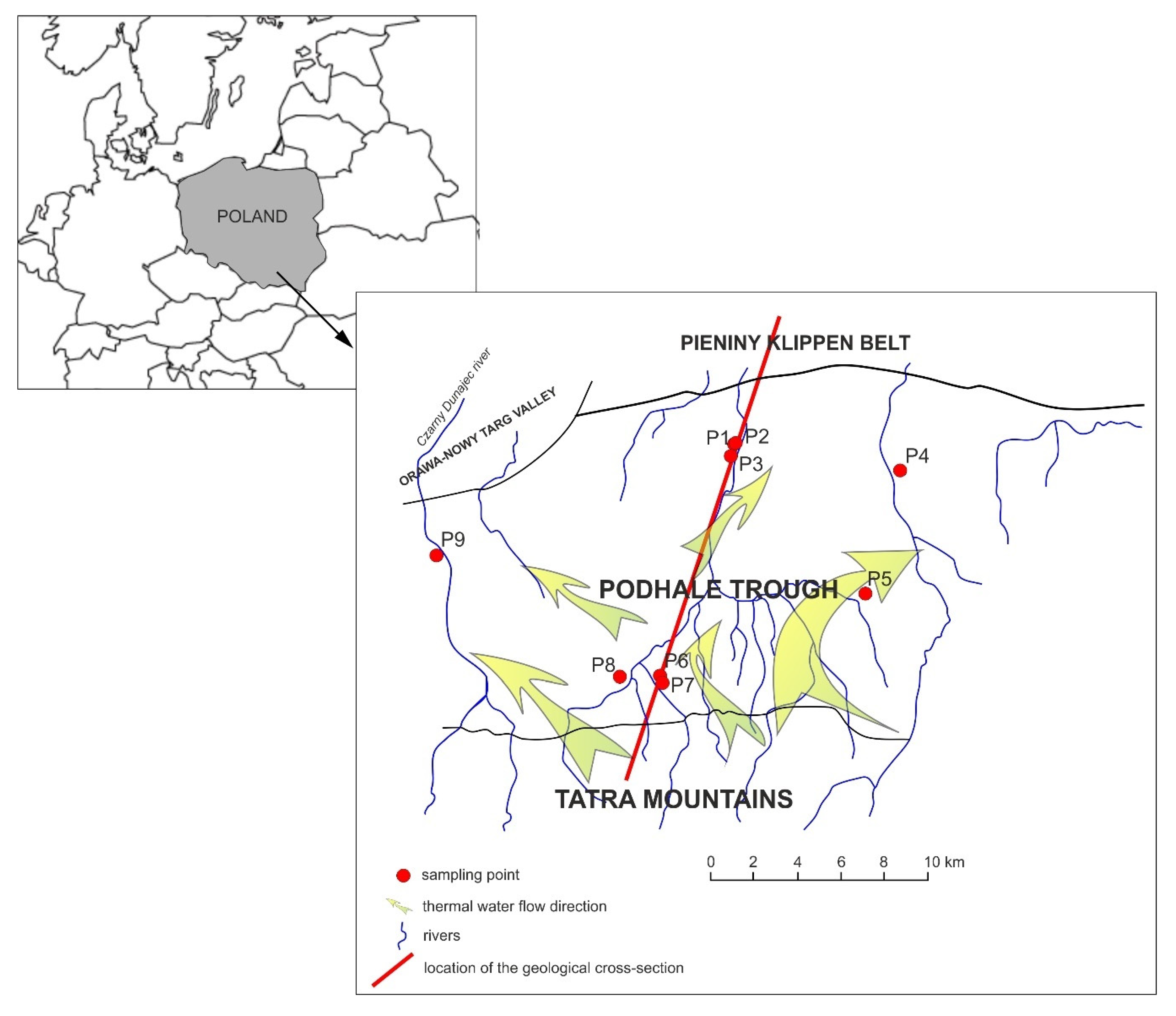






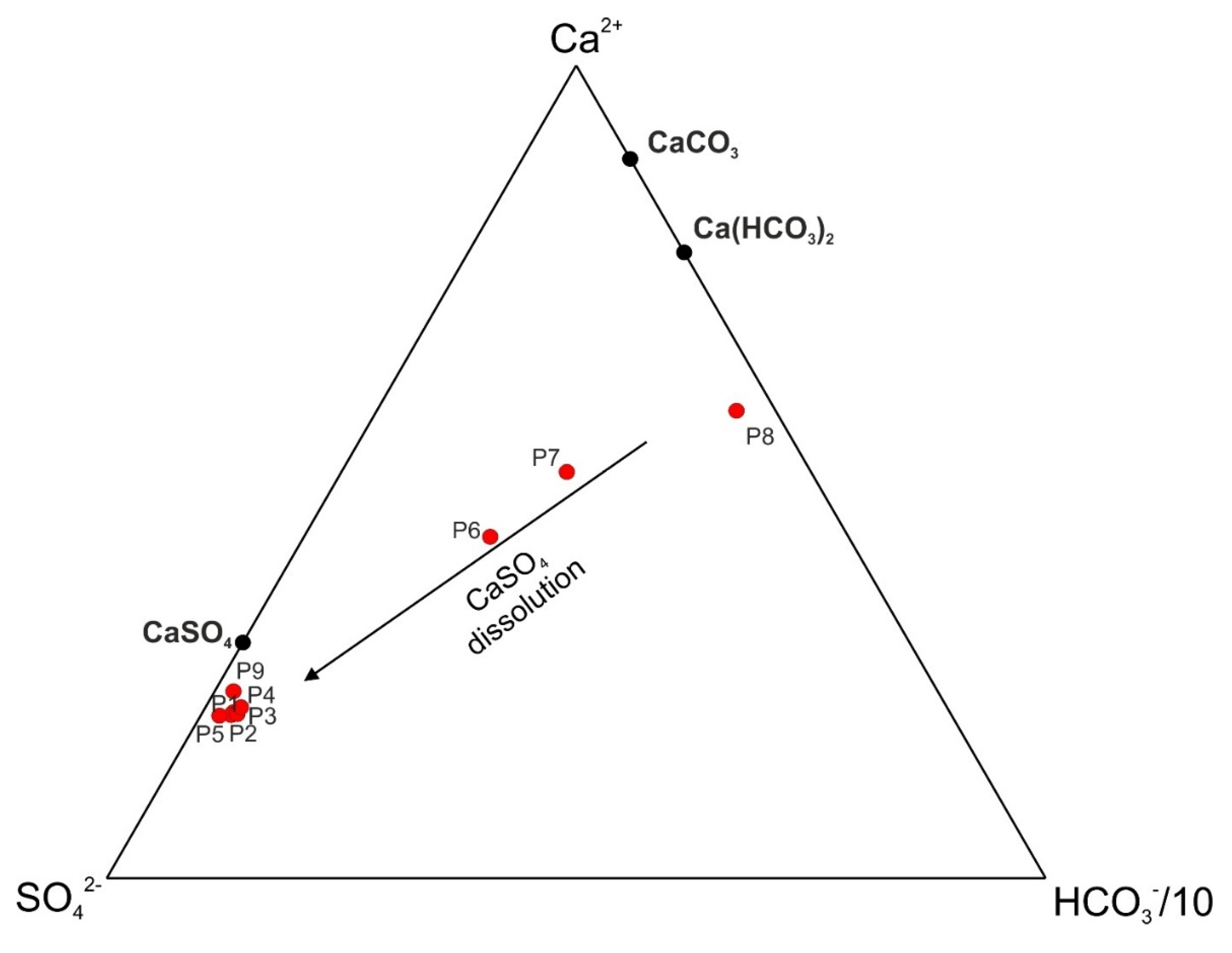
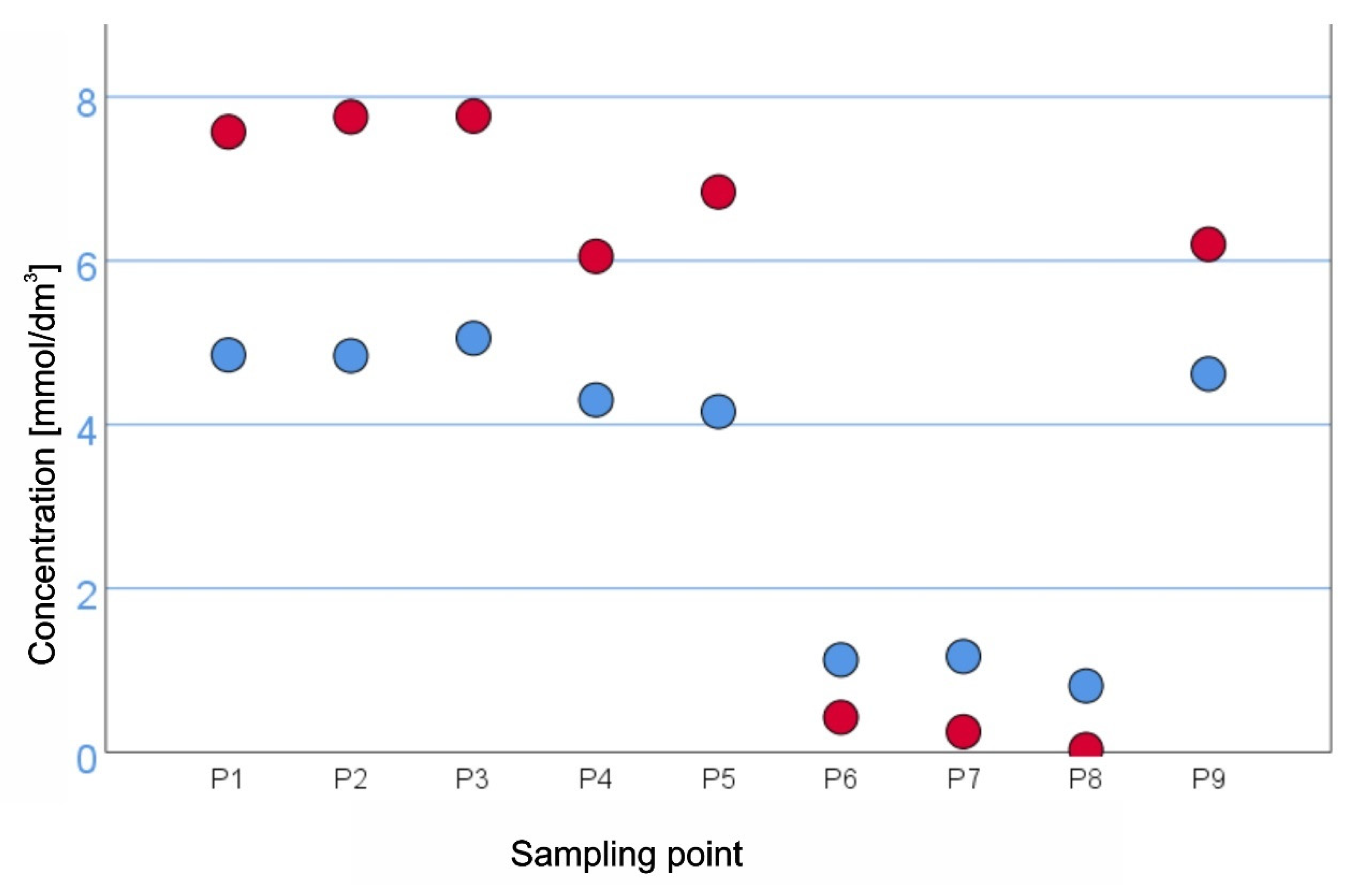
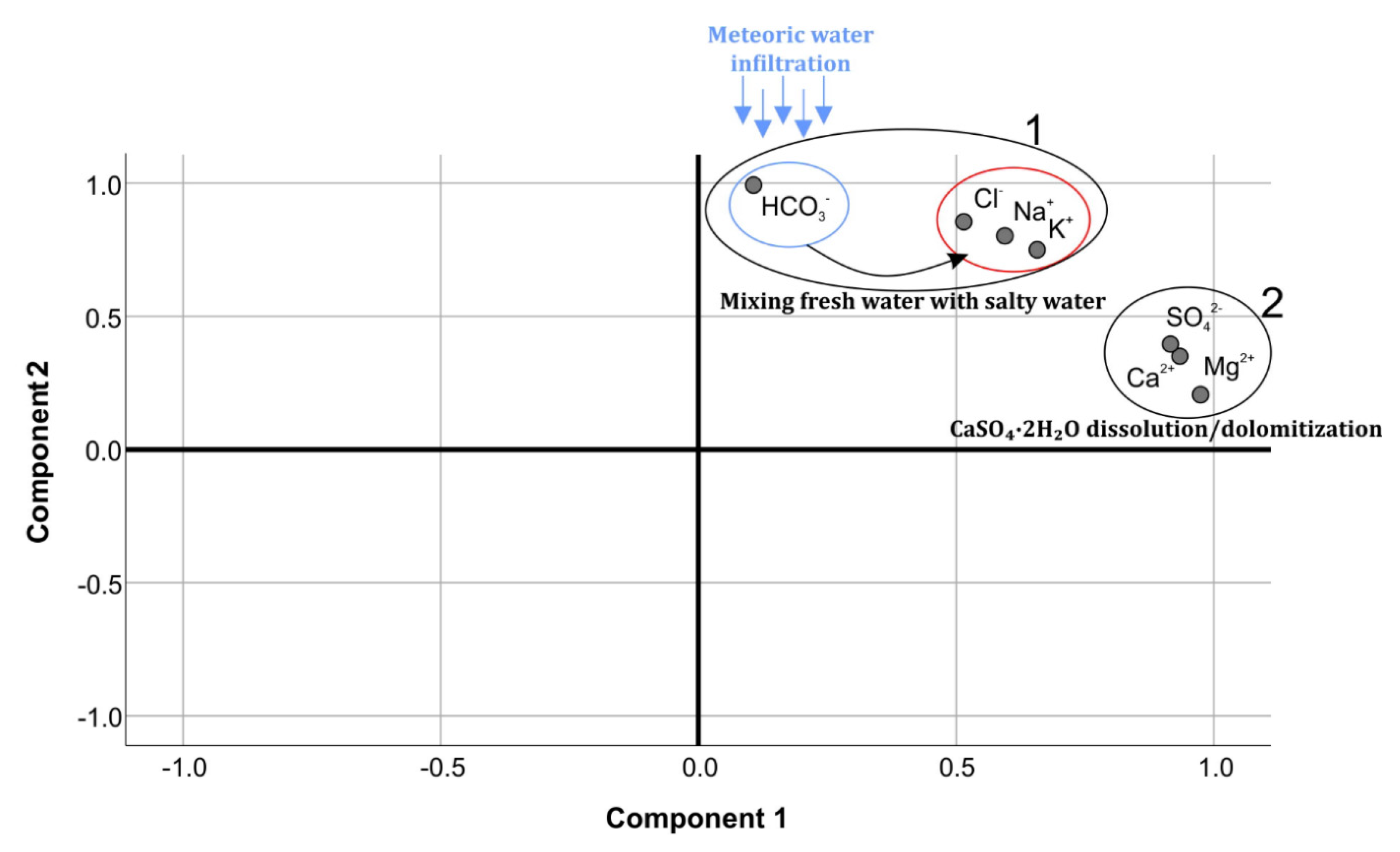
| Parameter | Sampling Point | ||||||||
|---|---|---|---|---|---|---|---|---|---|
| P1 | P2 | P3 | P4 | P5 | P6 | P7 | P8 | P9 | |
| Depth [m] | 3242.0 | 3400.0 | 5261.0 | 2500.0 | 3780.0 | 3073.2 | 1113.0 | 1737.0 | 3572.0 |
| pH [−] | 6.64 | 6.67 | 6.63 | 6.91 | 6.41 | 7.56 | 7.55 | 8.03 | 6.65 |
| EC [mS/cm] | 3.41 | 3.38 | 3.42 | 2.53 | 2.04 | 0.42 | 0.397 | 0.327 | 1.30 |
| T [°C] | 63.9 | 73.8 | 67.4 | 68.5 | 60.5 | 34.7 | 23.3 | 25.4 | 76.9 |
| Eh [mV] | −115,9 | −103.8 | −118.1 | −117.6 | −182.5 | −135.9 | −72.2 | −129.7 | −153.7 |
| Al [mg/dm3] | <0.005 | <0.005 | <0.005 | <0.005 | <0.005 | <0.005 | 0.006 | <0.005 | <0.005 |
| HCO3− [mg/dm3] | 318.0 | 316.4 | 316.4 | 249.3 | 207.8 | 211.0 | 223.8 | 222.2 | 156.6 |
| Ba [mg/dm3] | 0.054 | 0.052 | 0.054 | 0.027 | 0.020 | 0.091 | 0.080 | 0.099 | 0.036 |
| Br− [mg/dm3] | 1.005 | 0.768 | 0.785 | 0.591 | 0.358 | <0.1 | <0.1 | <0.1 | <0.1 |
| Ca2+ [mg/dm3] | 194.0 | 193.5 | 202.2 | 172.0 | 166.4 | 45.16 | 46.80 | 32.43 | 184.7 |
| Cl− [mg/dm3] | 470.7 | 474.9 | 474.9 | 328.2 | 166.2 | 3.9 | 3.3 | 3.4 | 18.7 |
| Cu [mg/dm3] | 0.0036 | 0.0037 | 0.0037 | <0.001 | <0.001 | <0.001 | 0.0029 | <0.001 | <0.001 |
| F− [mg/dm3] | 2.62 | 2.62 | 2.66 | 2.47 | 2.64 | 0.50 | 0.22 | 0.18 | 1.98 |
| Fe [mg/dm3] | 0.322 | 0.663 | 0.750 | 0.746 | 0.181 | 0.143 | 0.235 | 0.406 | 0.493 |
| K+ [mg/dm3] | 49.00 | 48.41 | 50.54 | 34.04 | 22.03 | 4.31 | 1.85 | 2.43 | 17.67 |
| Li [mg/dm3] | 1.041 | 1.047 | 1.096 | 0.623 | 0.581 | 0.026 | <0.005 | 0.016 | 0.122 |
| Mg2+ [mg/dm3] | 38.08 | 36.91 | 37.48 | 37.74 | 38.88 | 19.44 | 22.00 | 19.05 | 38.77 |
| Mn [mg/dm3] | <0.005 | 0.010 | 0.017 | 0.009 | <0.005 | <0.005 | <0.005 | 0.032 | <0.005 |
| NH4+ [mg/dm3] | 1.43 | 1.34 | 1.48 | 1.2 | 0.76 | 0.15 | 0.09 | 0.23 | 0.45 |
| NO2− [mg/dm3] | 0.06 | 0.1 | 0.12 | 0.08 | 0.06 | 0.08 | 0.06 | 0.07 | 0.08 |
| NO3− [mg/dm3] | <0.43 | <0.43 | <0.4 | <0.43 | <0.43 | <0.43 | <0.43 | <0.43 | <0.43 |
| Na+ [mg/dm3] | 438.4 | 441.6 | 455.6 | 276.6 | 221.3 | 10.3 | 1.7 | 6.3 | 68.3 |
| PO43− [mg/dm3] | <0.0061 | <0.0061 | <0.0061 | <0.0061 | <0.0061 | <0.0061 | <0.0061 | <0.0061 | <0.0061 |
| Pb [mg/dm3] | 0.0001 | 0.0001 | 0.0001 | 0.0001 | 0.0005 | 0.0001 | 0.0002 | 0.0001 | 0.0001 |
| SO42− [mg/dm3] | 726.9 | 744.7 | 745.5 | 581.1 | 656.6 | 40.9 | 24.0 | <3.0 | 595.3 |
| SiO2 [mg/dm3] | 53.27 | 53.08 | 54.45 | 49.03 | 37.53 | 15.3 | 6.14 | 4.4 | 49.74 |
| Sr [mg/dm3] | 5.94 | 5.91 | 6.13 | 5.65 | 4.94 | 1.06 | 0.44 | 0.36 | 4.77 |
| Zn[mg/dm3] | <0.01 | <0.01 | <0.01 | 0.051 | <0.01 | 0.046 | <0.01 | <0.01 | <0.01 |
| H2S+HS−+S2− [mg/dm3] | 0.16 | 0.21 | 0.28 | 0.38 | 5.76 | 0.46 | 0.12 | 0.16 | 0.75 |
| TDS [mg/dm3] | 2352 | 2374 | 2404 | 1773 | 1750 | 359.0 | 333.9 | 297.6 | 1156 |
| Hydrochemical type | SO4-Cl-Na-Ca | HCO3-Ca-Mg | SO4-Ca-Mg | ||||||
| Parameter | Statistics | Sampling Point [Number of Analysis] | ||||||||
|---|---|---|---|---|---|---|---|---|---|---|
| P1 [n = 48] | P2 [n = 36] | P3 [n = 26] | P4 [n = 7] | P5 [n = 54] | P6 [n = 9] | P7 [n = 9] | P8 [n =6 ] | P9 [n = 41] | ||
| Na+ [mg/dm3] | Min | 441.0 | 443.1 | 462.3 | 272.3 | 173.7 | 8.7 | 1.4 | 3.1 | 52.5 |
| Mean | 485.7 | 482.5 | 491.3 | 314.6 | 222.4 | 10.17 | 1.70 | 5.89 | 69.1 | |
| Max | 551.5 | 576.7 | 554.6 | 410.7 | 250.6 | 12.3 | 2.0 | 6.0 | 82.7 | |
| K+ [mg/dm3] | Min | 3.7 | 41.0 | 42.3 | 29.5 | 16.4 | 2.6 | 0.4 | 0.7 | 10.6 |
| Mean | 45.6 | 45.8 | 46.9 | 33.6 | 20.5 | 3.38 | 1.22 | 1.82 | 16.3 | |
| Max | 56.8 | 58.8 | 53.9 | 36.7 | 29.9 | 4.4 | 1.6 | 2.2 | 20.7 | |
| Ca2+ [mg/dm3] | Min | 179.9 | 184.3 | 182.2 | 157.8 | 138.7 | 39.5 | 40.7 | 36.6 | 145.3 |
| Mean | 201.5 | 199.2 | 204.9 | 179.4 | 165.3 | 43.9 | 45.4 | 39.8 | 177.0 | |
| Max | 273.5 | 236.1 | 271.6 | 191.6 | 202.3 | 46.6 | 47.8 | 41.9 | 200.6 | |
| Mg2+ [mg/dm3] | Min | 36.6 | 35.9 | 35.8 | 36.6 | 32.8 | 18.3 | 20.5 | 20.7 | 31.7 |
| Mean | 41.1 | 40.1 | 40.0 | 42.9 | 41.8 | 19.8 | 22.4 | 22.0 | 38.7 | |
| Max | 48.4 | 48.5 | 45.0 | 55.2 | 62.3 | 21.4 | 24.2 | 23.9 | 56.2 | |
| Cl− [mg/dm3] | Min | 449.2 | 462.9 | 460.5 | 293.8 | 147.3 | 2.1 | 3.0 | 2.6 | 8.3 |
| Mean | 497.7 | 486.0 | 500.5 | 333.2 | 172.8 | 3.40 | 3.65 | 3.98 | 19.3 | |
| Max | 595.5 | 615.5 | 635.7 | 361.0 | 214.5 | 7.6 | 5.1 | 6.0 | 43.5 | |
| SO42− [mg/dm3] | Min | 711.2 | 722.2 | 718.2 | 570.3 | 526.1 | 33.0 | 17.1 | 6.4 | 403.5 |
| Mean | 830.9 | 820.4 | 844.9 | 656.2 | 672.5 | 44.4 | 22.93 | 15.3 | 567.4 | |
| Max | 1046 | 963.5 | 1041 | 849.4 | 1094 | 60.2 | 30.0 | 17.6 | 676.1 | |
| HCO3− [mg/dm3] | Min | 289.0 | 292.1 | 289.0 | 221.0 | 166.9 | 197.9 | 208. | 212.1 | 126.3 |
| Mean | 319.4 | 317.7 | 323.9 | 254.2 | 212.3 | 215.6 | 226.0 | 232.5 | 175.8 | |
| Max | 355.7 | 347.1 | 362.3 | 283.0 | 282.8 | 241.5 | 240.3 | 245.2 | 244.4 | |
| pH [−] | Min | 6.4 | 6.4 | 6.4 | 6.6 | 6.6 | 6.8 | 7.0 | 6.7 | 6.9 |
| Mean | 6.71 | 6.61 | 6.63 | 6.77 | 7.04 | 7.31 | 7.39 | 7.39 | 7.22 | |
| Max | 7.9 | 8.0 | 7.3 | 7.0 | 7.55 | 7.7 | 7.7 | 7.7 | 8.8 | |
| EC [mS/cm] | Min | 2.5 | 2.6 | 3.1 | 2.5 | 1.9 | 0.4 | 0.4 | 0.4 | 1.4 |
| Mean | 3.29 | 3.39 | 3.45 | 2.59 | 2.12 | 0.402 | 0.376 | 0.360 | 1.41 | |
| Max | 3.6 | 3.7 | 3.7 | 2.7 | 2.2 | 0.4 | 0.4 | 0.4 | 1.5 | |
| T [°C] | Min | 82.9 | 82.5 | 21.4 | 74.0 | n.a. | 22.0 | 20.0 | 25.0 | 70.4 |
| Mean | 85.68 | 84.97 | 77.99 | 75.00 | n.a. | 31.78 | 22.08 | 26.14 | 83.43 | |
| Max | 86.4 | 85.2 | 80.7 | 77.0 | n.a. | 35.0 | 23.5 | 27.0 | 88.5 | |
| Sampling Point | fM Calculated Based on Current Results | fM Calculated Based on Archival Results | ||
|---|---|---|---|---|
| Mean | Minimum | Maximum | ||
| P1 | 0.69 | 0.75 | 0.66 | 0.84 |
| P2 | 0.70 | 0.76 | 0.67 | 0.88 |
| P3 | 0.70 | 0.73 | 0.64 | 0.86 |
| P4 | 0.70 | 0.73 | 0.67 | 0.84 |
| P5 | 0.86 | 0.73 | 0.66 | 0.92 |
| P6 | 0.85 | 0.89 | 0.85 | 0.98 |
| P7 | 0.84 | 0.88 | 0.83 | 0.97 |
| P8 | 0.91 | 0.90 | 0.81 | 0.97 |
| P9 | 0.89 | 0.79 | 0.63 | 0.89 |
| Hydrochemical Ratios | Sampling Points | ||||||||
|---|---|---|---|---|---|---|---|---|---|
| P7 | P6 | P8 | P5 | P9 | P4 | P1 | P2 | P3 | |
| rHCO3−/rCl− | 39.41 | 31.44 | 37.98 | 0.73 | 4.87 | 0.44 | 0.39 | 0.39 | 0.39 |
| rNa+/rCl− | 0.79 | 4.07 | 2.86 | 2.05 | 5.63 | 1.30 | 1.44 | 1.43 | 1.48 |
| rCa2+/rMg2+ | 1.3 | 1.4 | 1.0 | 2.6 | 2.9 | 2.8 | 3.1 | 3.2 | 3.3 |
| rCa2+/(rCa2+ +r SO42−) | 0.82 | 0.73 | 0.96 | 0.38 | 0.43 | 0.41 | 0.39 | 0.38 | 0.39 |
| rNa+/(rNa+ + rCl−) | 0.44 | 0.80 | 0.74 | 0.67 | 0.85 | 0.57 | 0.59 | 0.59 | 0.60 |
| Kaiser-Meyer-Olkin Measure of Sampling Adequacy | 0.694 | |
|---|---|---|
| Bartlett’s Test of Sphericity | Approx. Chi-Square | 132.085 |
| Degrees of freedom | 21 | |
| Sig. level | 0.000 | |
Publisher’s Note: MDPI stays neutral with regard to jurisdictional claims in published maps and institutional affiliations. |
© 2020 by the authors. Licensee MDPI, Basel, Switzerland. This article is an open access article distributed under the terms and conditions of the Creative Commons Attribution (CC BY) license (http://creativecommons.org/licenses/by/4.0/).
Share and Cite
Sekuła, K.; Rusiniak, P.; Wątor, K.; Kmiecik, E. Hydrogeochemistry and Related Processes Controlling the Formation of the Chemical Composition of Thermal Water in Podhale Trough, Poland. Energies 2020, 13, 5584. https://doi.org/10.3390/en13215584
Sekuła K, Rusiniak P, Wątor K, Kmiecik E. Hydrogeochemistry and Related Processes Controlling the Formation of the Chemical Composition of Thermal Water in Podhale Trough, Poland. Energies. 2020; 13(21):5584. https://doi.org/10.3390/en13215584
Chicago/Turabian StyleSekuła, Klaudia, Piotr Rusiniak, Katarzyna Wątor, and Ewa Kmiecik. 2020. "Hydrogeochemistry and Related Processes Controlling the Formation of the Chemical Composition of Thermal Water in Podhale Trough, Poland" Energies 13, no. 21: 5584. https://doi.org/10.3390/en13215584
APA StyleSekuła, K., Rusiniak, P., Wątor, K., & Kmiecik, E. (2020). Hydrogeochemistry and Related Processes Controlling the Formation of the Chemical Composition of Thermal Water in Podhale Trough, Poland. Energies, 13(21), 5584. https://doi.org/10.3390/en13215584





